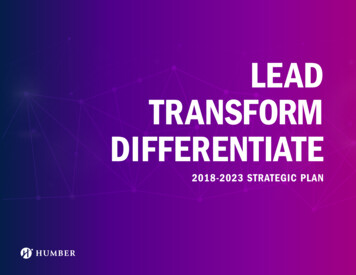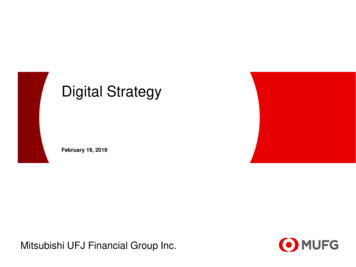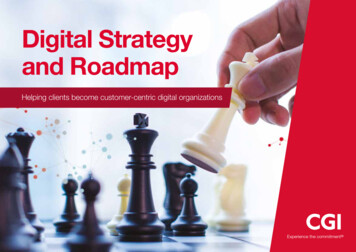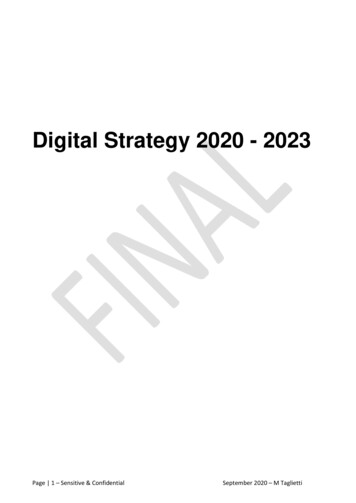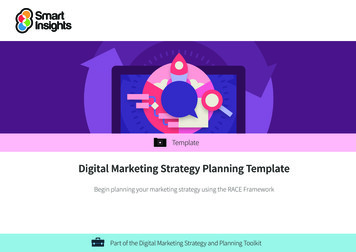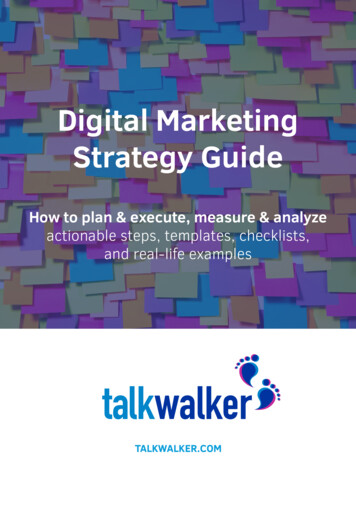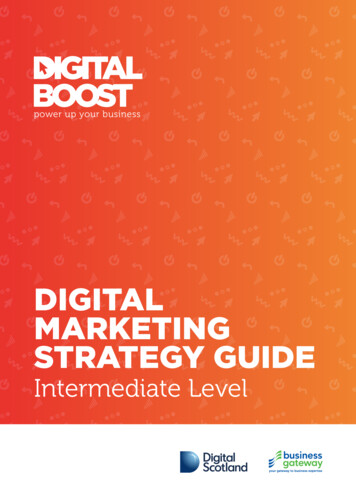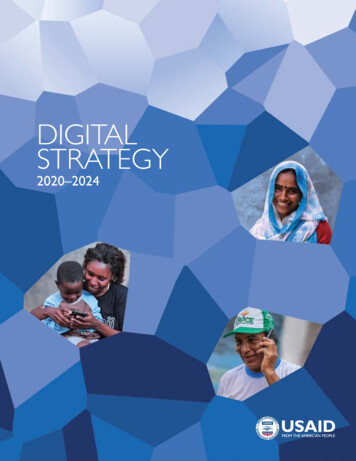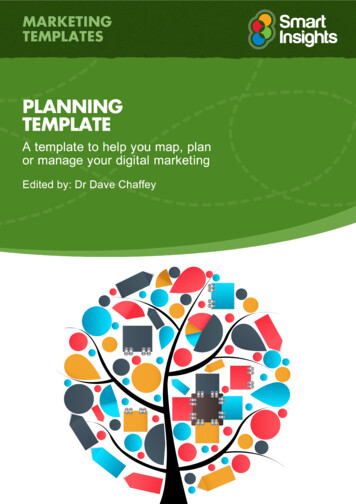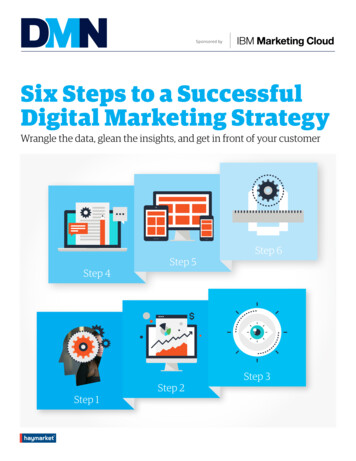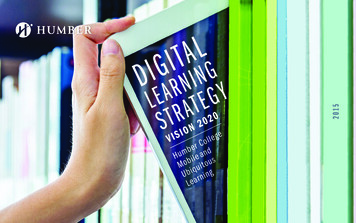
Transcription
DI ARNINL E A T E G0 YS VTI SRI O N 2 0 2egelloer C dbmHu bile an sMo quitouUbi rningLea2015LATIG G
BUILDING HUMBER’S DIGITAL STRATEGYBeginning in late 2013 and continuing through 2014, a committee comprising members of the Centrefor Teaching & Learning, Curriculum Planning and Development, and Informational Technology Services(ITS) undertook the task of soliciting ideas and suggestions about the future of learning from key Humberstakeholders. Interviews with School Leadership: The committee organized visioning sessions withHumber’s various Deans and Associate Deans, who spoke to the desired outcome of anexpansion of Digital Learning. Roundtable Sessions with Faculty and Students: Four eLearning roundtable sessionswere held with faculty, during which participants were asked to comment and offersuggestions related to Learning Materials, Quality, Learning Experience, Policies,Resources, Support and Technology. In addition, a roundtable session was held withstudents who had taken online courses at Humber. Online Student Survey: All Humber students were asked to participate in a voluntaryonline survey related to online and digital learning. More than 1,000 studentsparticipated.The committee also commissioned a leading educator and expert in distance education to perform athorough review and assessment of Humber’s current online teaching, and to make recommendations forfuture development.2
The information gathered throughout this intensiveand wide-ranging process has been instrumentalin the creation of the Digital Learning Strategy.Eileen De Courcy, Associate Vice President,Teaching and Learning, wishes to extend herspecial thanks to the following people for theircontribution in the development of this strategy:Guillermo AcostaDebbie JohnstonAndrew AinsworthSusan KelsallStephen AllenJoseph KertesGina AntonacciHeather LowryScott BriggsPeter MadottAvril CarnovaleRebecca MillburnJames CullinJason PowellLenore DuquetteNancy RodriguesJason GaleaTheresa StegerPaula GouveiaLisa TeskeyMark HannaGail ThorntonNazlin HirjiDawnMarie WarrenMark IhnatSheila West-MerkerThis document was designed by Dekel Chui and edited by Nathan Whitlock.3
THE FUTURE OF LEARNING AT HUMBERIn an era in which students are able to instantly access vastamounts of information on mobile devices, or gather together inreal-time virtual spaces, institutions of higher education mustbreak away from the traditional models of teaching and learning.This is a challenge that Humber College sees as an opportunity —to evolve, to grow and to offer students a more creative approachto higher education.In its current strategic plan, Humber commits itself toStrengthening our Polytechnic Identity, to a Sustained Focus onTeaching and Learning Excellence, and to Maximizing the Impactof Partnerships. To reach these goals, Humber must encouragecuriosity, creativity, innovation and collaboration, and promotelifelong learning. Digital Learning that is Mobile and Ubiquitous isa crucial part of fulfilling this vision.4
Implicit in these goals and strategies is a visionof teaching and learning in which students arenot merely passive consumers of content, butare actively and creatively engaged in their owneducation and in preparing themselves for alifetime of active learning. Mobile and UbiquitousLearning, the core of Humber’s Digital LearningStrategy, requires a wholesale redefinition ofthe role of a modern educational institution. Itis a vision that extends beyond the traditionalboundaries of the classroom and campus, andeven beyond the borders of our city, provinceand country.This document outlines Humber’s vision forteaching and learning in an information age. Withinput from stakeholders across the spectrum –administration, faculty, students, outside experts– it offers a road map for a comprehensiveplan for the further expansion and integrationof digital, mobile and ubiquitous technologiesacross all schools and programs. It also lays outthe vision for Humber Online, which will becomethe new central hub for all fully online learningat Humber and help build our brand locally,nationally and internationally.5
HUMBER’S COMMITMENTHumber’s approach to Digital Learning must reflect the following principles:LE ARNER-CENTRED EDUC ATION IN THE21 S T C E N T U R Y C O N T E X TThe current and future success of students mustbe held as the highest priority in developing andoffering mobile and ubiquitous learning programs.This can be done by rethinking the design anddelivery approach of online courses and throughthe development of courses and programs that aremodular, stackable, adaptable and personalized.By increasing Humber’s technological abilities, weoffer students a greater opportunity to completea relevant, meaningful course of study on a fluidtime continuum. Access to and the frequency bywhich a course/module is offered will improve thetime to diploma/degree completion. Increasingthe amount of digital content available willalso enhance Humber’s differentiated learningplatform in support of all students and Humber’scommitment to AODA.6TEACHING AND LEARNING EXCELLENCEWe believe that a Digital Learning framework thatutilizes a multi-platform, technology-enrichedapproach to teaching and learning will improveour current capabilities in delivering high qualityeducation in the 21st century. We must ensureexcellence in the use of all technology-enrichedin-class and mobile/digital learning by equippingboth teachers and students with the tools andskills they need to be successful.FLEXIBILIT YDigital Learning that is mobile and ubiquitiousoffers Humber the ability to offer programs thatcan be modified and personalized for students inorder to help them achieve their desired outcomes.This can be done by rethinking the design anddelivery approach of online courses and throughthe development of courses and programs thatare adaptive, personalized, modular, stackableand adaptive. Using smart adaptive technologieswill transform the learning experience from onethat sees time as a fixed variable to one that seestime as a fluid variable. Adaptive learning acrossthe curriculum will allow students to demonstratecompetency and skills in subject/discipline areasat their own individual rate and pace.SUSTAINABILIT YHumber must assess the costs associated withthe implementation and ongoing maintenanceof technologies, digital curriculum and physicalinfrastructure and have the financial resourcesto stay current with technologies as they evolveand are upgraded. All offerings must be regularlyreviewed and updated reflecting high standardsfor an exceptional student experience. Digitalprograms, in particular, must adhere to the samehigh standards as traditional in-class learning.
R E A L- W O R L D R E L E V A N C EOffering programs that blend applied andtheoretical education, and that develop students’job-specific skills, is a core Humber commitment.Digital Learning experiences that are mobile andubiquitous must focus on the essential skillsthat prepare graduates for success in work andlife as well as deliver on program outcomes. Allcourses and programs should make the real-worldrelevance explicit and provide outcomes thatdemonstrate application. Work-integrated learningmust be a critical part of all online programs.E X PERIMEN TAT ION, INNOVAT ION AND PL AYDigtial Learning that is mobile and ubiquitousallows Humber the opportunity to experiment withdifferent teaching methods and approaches andto create programs and courses that are unique,dynamic and adaptive and that encourage studentengagement and lifelong learning.7
VISION,GOALS & STRATEGIC PRIORITIESHumber will become a leader in the delivery of Digital Learningin post-secondary education and recognized as a Centre ofExcellence. All Humber students and faculty will have theopportunity to learn and teach using current technology in flexibleformats and in digitally enriched environments.8
Our fundamental commitment to excellence will be fully reflected in the ongoing development of DigitalLearning at Humber. The following goals and strategic priorities have been established:1 Enhance Student Experience with thedevelopment of a Digital Learning Platform thatis Mobile and UbiquitousDigital Expertise and Institutional2 BuildCapacityThrough a Networked Community3 InnovateWithin and Beyond Humber9
GOAL ONEEnhance the Student Experience with the development of a DigitalLearning Platform that is Mobile and UbiquitousThrough new supports for teachers and learners and the creation of clear quality measures and designcriteria across the curricula, Digital Learning that is Mobile and Ubiquitous will enhance educational anduser experiences. This approach will aid in the development of technology-related competencies anddigital literacy skills that enable students to engage with the economy and with society at large.Re-conceptualize student access and programdelivery frameworks1AEstablish Humber Online as a new entity to increaseaccess to mobile and ubiquitous learning1B1C1DDemonstrate leadership in the design anddevelopment of Mobile and Ubiquitous Learning2A3AEvaluate and increase the number of programs offeredfully and partially in mobile and digital formatDeploy a Digital Learning Quality Framework, includingan Online Course Development and Quaiity ReviewprocessCreate a diagnostic self-assessment tool to helpstudents identify readiness for learning in a fullydigital environment2BIntegrate smart adaptive technology and dataanalytics to personalize the student learningexperience3BEstablish and deploy a robust e-resource solution,including etexts, open resources and multimediasolutionsProvide Humber’s fully online students access to asuite of online academic, career and support services3C2CIncrease the utilization of educational technologies inlearning delivery through the use of LMS, Simulations,Augmented Reality and Virtually Reality, 3D printingUpdate and reinvent the OLC to better serve digitallearning needs3DOffer Virtual Proctoring to all studentsIncrease the number of channels by which studentscan access learning – iTunes U, EdU, MOOCs2D10Provide best-in-class online student servicesUsing learning analytics, establish benchmarks toincrease the use of educational technology in learning
GOAL TWOBuild Digital Expertise and Institutional CapacityLearning, teaching and productivity processes have been greatly transformed by technology. Attracting,developing and maximizing talent to thrive within the digital organization will position Humber as a globalleader in Digital Learning and education.Ensure academic, planning/operations, andHR practices connect to and reflect a renewedfocus on Digital Learning1AIdentify teaching qualifications and competencies forfaculty delivering in fully online environments1BUpgrade current hiring practices and policies toinclude digital competency1CReview and upgrade, where appropriate, allinstitutional policies with a digital learning lens,including student regulations and code of conduct1DEstablish Academic Integrity policy and practices thataccount for the digitization of learning1EUpdate test and exam practices for a digital worldProvide Faculty and staff with opportunitiesto develop and demonstrate their ability andadaptability using current technologies2AIncrease the number of faculty participating intechnology pilots, technology training programs,technology-related workshops, tech buddyprogramming2BCreate a training/development certificate for facultywho are interested in teaching online2CProvide opportunities for classroom observations andpeer-to-peer reviews in the online environment2DProvide opportunities for all qualified faculty to teachonlineDemonstrate Humber’s commitment to 21stcentury education by providing resources tosupport digital/information-age services forfaculty and staff3AProvide opportunities for faculty to access new andemerging technologies and support adoption inpractice3BCreate faculty technology training spaces3CDedicated resources to support faculty and staff suchas: Educational Technologist and Digital CurriculumSpecialist11
GOAL THREEInnovate Through a Networked Community Within and beyondHumberDigital Learning tha is Mobile and Ubiquitous Learning creates new opportunities and new modelsfor learning and research and lets us reshape our physical and virtual campuses in order to facilitate21st-century education. Humber commits to expanding its current efforts to maximize the potential ofinnovation and innovative approaches to teaching and learning.Develop and sustain a leading edge, fullyintegrated digital infrastructureUtilize educational and industry partnershipsto develop innovative approaches to teaching &learningCreate a platform for the sharing of ideas,experimentation and play with new technologies1AResearch the impact of redesigned classrooms thatsupport digital learning2AAlign project-based learning approaches and industrypartners in online programs3AAdvance innovation through shared research projectswith industry1BDevelop learning space standards that support labvirtualization and a bring-your-own-device approach2BDeliver learning onsite and in partnership with industrypartners using enhanced technology and virtualization3B1CEstablish a plan to redevelop learning spacesthroughout the institution2CDevelop dedicated innovation rooms sponsored bycorporate partnersDevelop a research centre on the use of teachingtechnologies and digital innovations in the delivery ofHumber’s programming and services12
13
DEFINITIONSAdaptive LearningSupports mastery-based personalized learningcapabilities in traditional and emergingcompetency-based learning models usingcomputers as interactive teaching devices.Fully Online DeliveryAn instructor-led learning experience using avariety of learning technologies to deliver thecontent and facilitate learning for an entire course.Online students are provided the opportunityto actively interact with the course content,classmates and
Learning, the core of Humber’s Digital Learning Strategy, requires a wholesale redefinition of the role of a modern educational institution. It is a vision that extends beyond the traditional boundaries of the classroom and campus, and even beyond the borders of our city, province and country. This document outlines Humber’s vision for teaching and learning in an information age. With .
